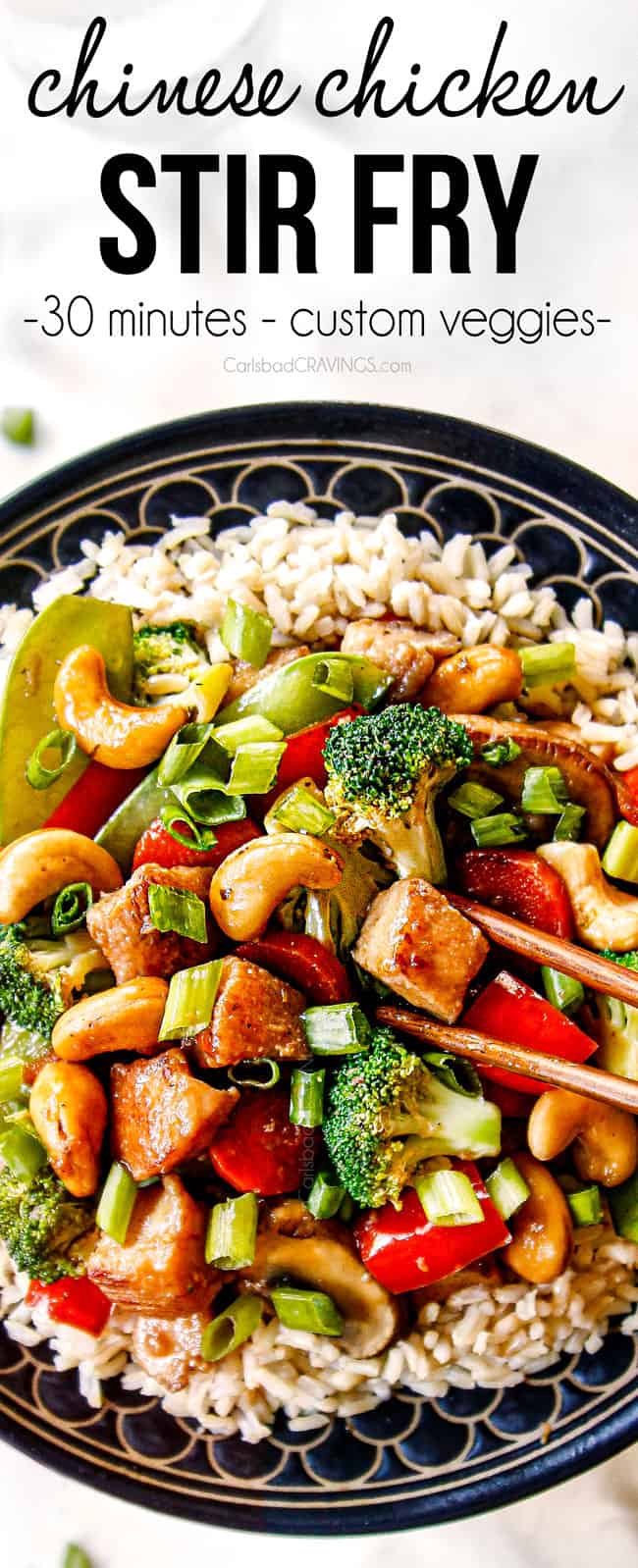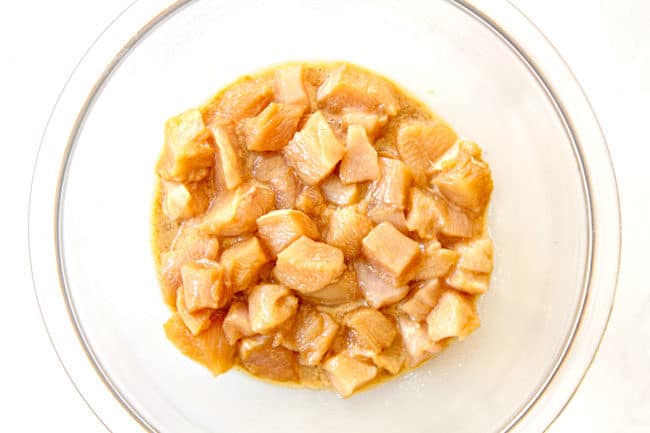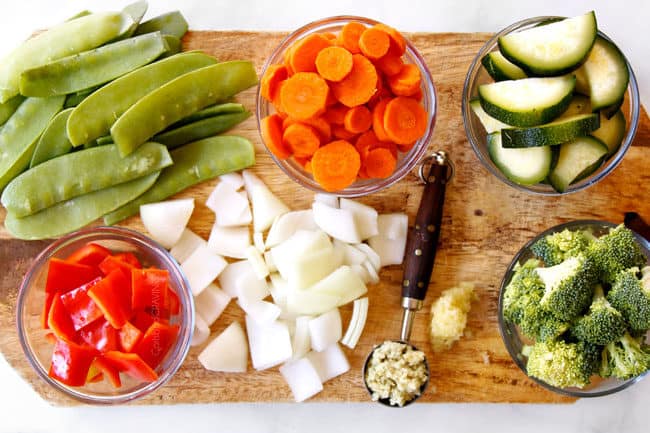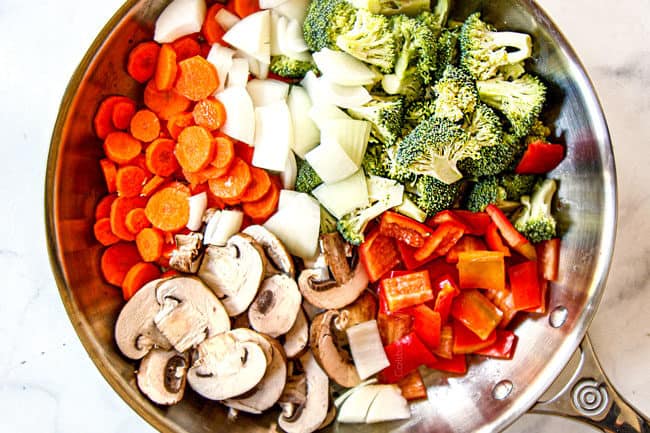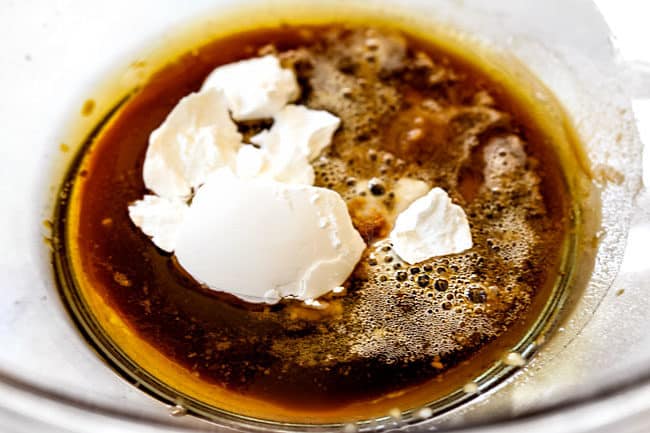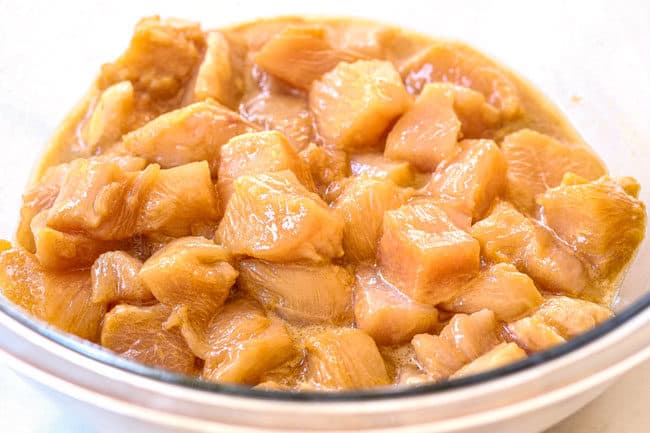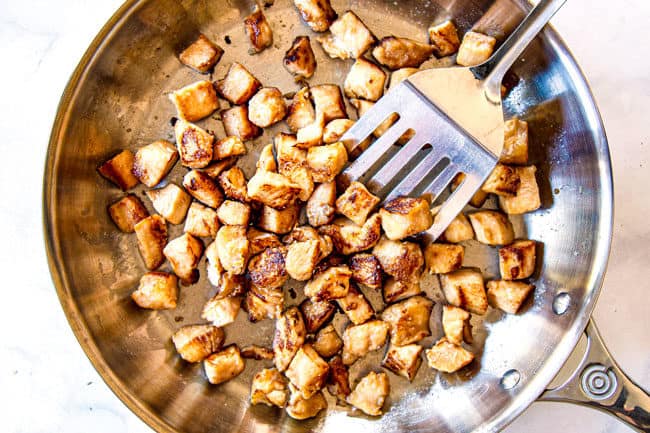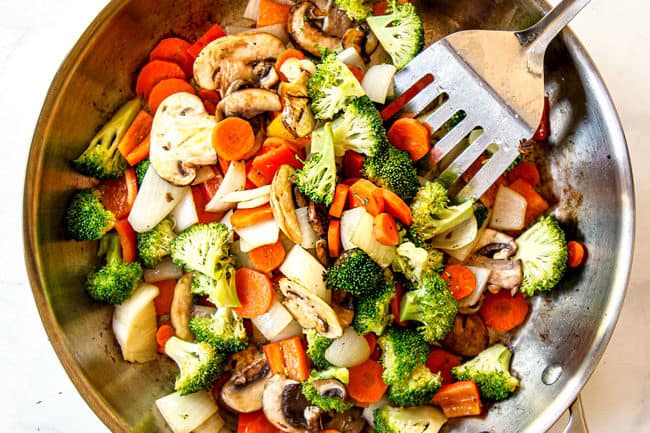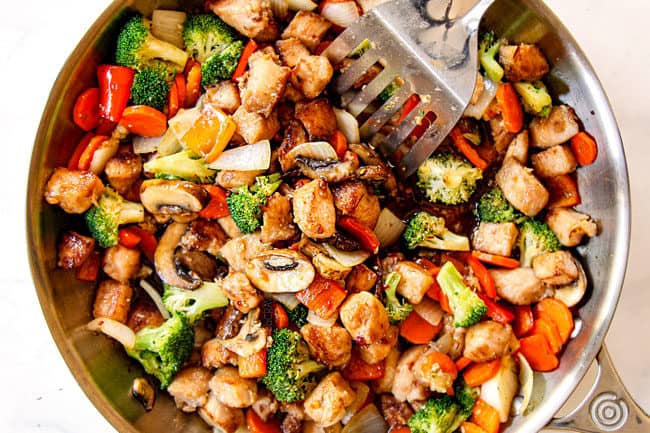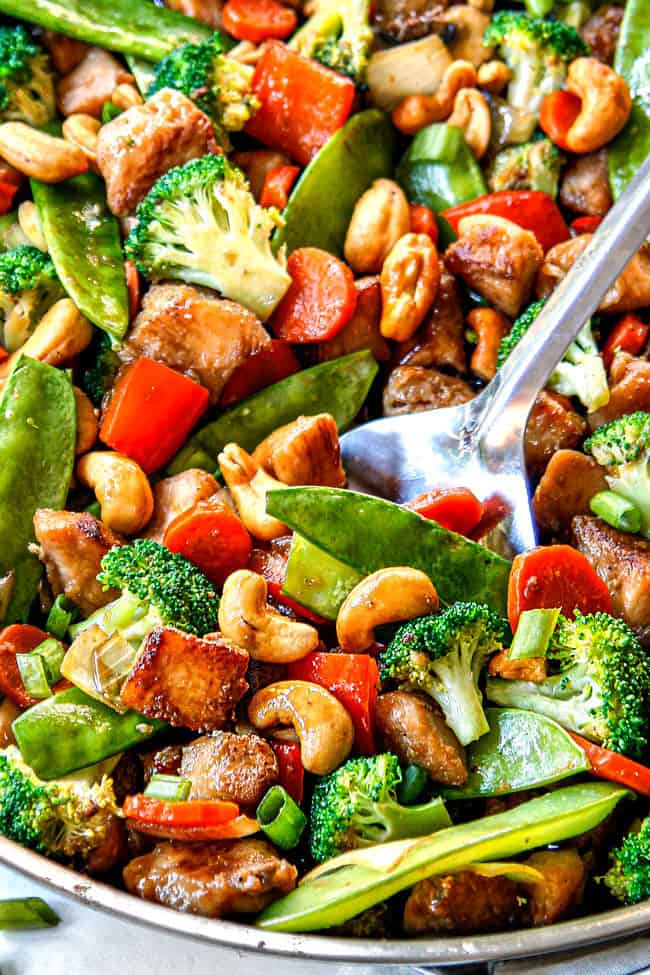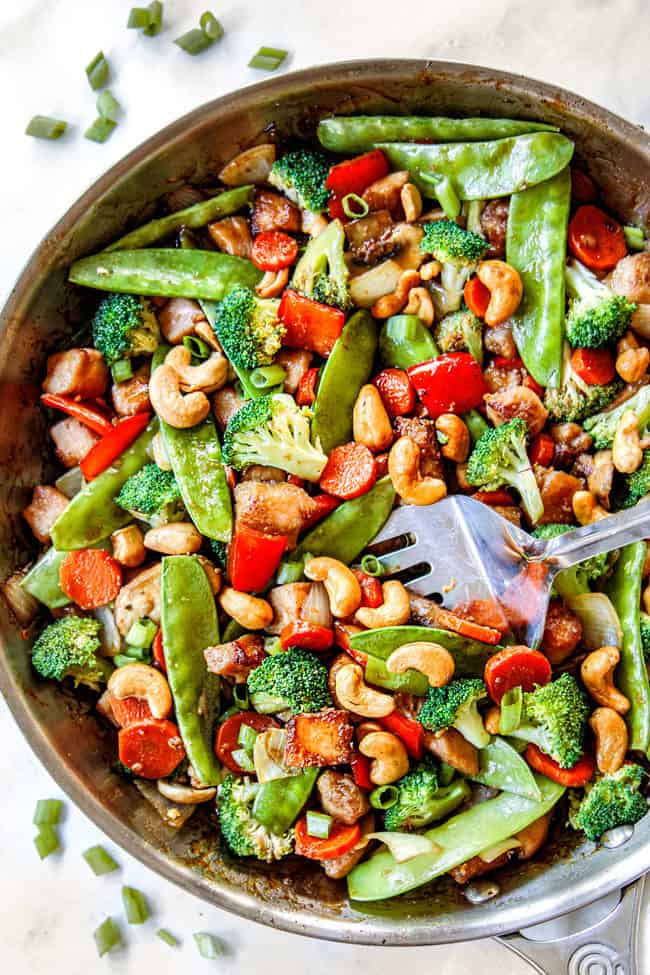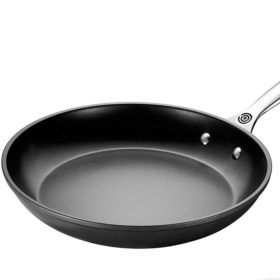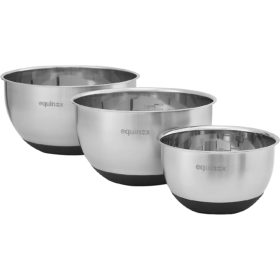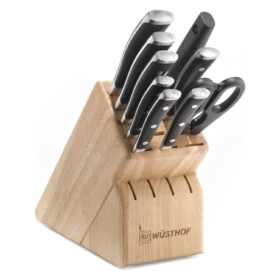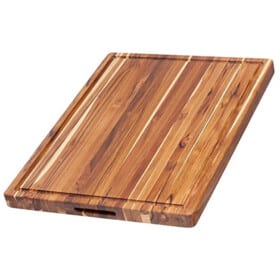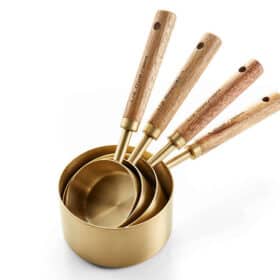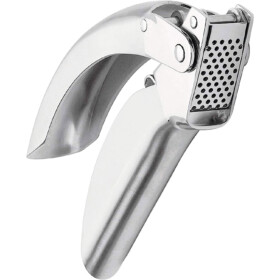PIN THIS RECIPE TO SAVE FOR LATER
Our Favorite Chicken Stir Fry
I am a huge fan of one skillet dinners and sheet pan meals – you just can’t beat your protein and veggies all cooked in one pan – hassle free! A few of my repeat favorite one pan meals include Coconut Curry Chicken, Toscana Tortellini, Korean Beef Bowls, Chili Mac, Skillet Penne, Red Curry Chicken, Mexican Chicken and Rice and One Pot Lasagna Soup. But you know what I make more than any other skillet dinner? Chicken Stir Fry! We love a good chicken stir fry recipe around here. They are my go-to meal whenever I want something simple, quick, easy, healthy and delicious OR whenever I want to clean out my veggie drawer – so, I finally got around to writing down my unwritten recipe and am excited to bring it to you! This healthy chicken stir fry recipe is one for the weekly meal plan. You will fall in love with the medley of vibrant, fresh crisp-tender veggies dripping in an intoxicating savory, sweet sauce AND you will love how easy it is! All you need is the chicken, the sauce and the veggies – which are super flexible. I also like to mix up how I serve my stir chicken fry recipes: over rice, zoodles, or ramen, or even in lettuce wraps and I always add some sort of CRUNCH from toasted peanuts to cashews. But no matter how you serve this easy chicken stir fry recipe; you will LOVE it every time!
Why we love this Chicken Stir Fry Recipe
Family friendly: everyone loves a quick chicken stir fry AND you know your family so you can customize it just how they like it. QUICK and easy: chop your chicken and veggies, whisk your chicken stir fry sauce together and cook! Simple ingredients: the chicken stir fry sauce uses pantry staples so you can make it any time. Customizable: swap the chicken for shrimp, pork or beef and use whatever veggies you have on hand; add more or less heat, any variety of CRUNCH such as peanuts, cashews or water chestnuts and/or even add fruit such as pineapple or mangos. FLAVOR! the chicken stir fry sauce is bursting with aromatic garlic and ginger along with soy sauce, chicken broth, oyster sauce and sriracha for a savory, addictive sauce that envelops every nook and cranny of the fresh stir-fried veggies. JUICY and so TENDER: I’ve included a simple velveting technique for the chicken that will leave you speechless! We’re talking SO tender, juicy and moist – you will never go back – and it only take minutes!
Now, I’m going to break down this chicken stir fry recipe and try and answer all your questions as well as offer some tips and tricks. You can use my “jump to recipe” button at the top of the page to skip straight to the recipe.
CHICKEN STIR FRY SAUCE
The fantastic thing about chicken stir fry sauce (aside from enlivening your entire stir fry) is that it can be whisked or shaken together in minutes, stored for weeks, then just thrown into the skillet when you’re ready to cook! The BEST chicken stir fry needs the best chicken stir fry sauce! I’ve tried many different combinations over the years and the resulting recipe is the winner – for us. It’s made with chicken broth, soy sauce, oyster sauce, Japanese rice wine, brown sugar Asian chili sauce, sesame oil, pepper and cornstarch. It delivers a savory, salty, deeply flavorful satisfying richness.
Chicken Stir Fry Sauce Breakdown:
QUICK. This chicken stir fry sauce probably takes 3 minutes to make! Just whisk the ingredients together or shake them up in a mason jar. Make ahead. After you whisk the sauce together, you can store it in an airtight container in the fridge for weeks. When ready to use, just shake again and throw into your sizzling hot skillet. Adaptable. While this stir fry sauce is just right for us, you can adjust it to make it just right for YOU and your family’s personal tastes. Just keep a note of your adjustments then whip out the perfect stir fry sauce every time. sweeten it up with additional brown sugar or swap the sugar for honey add sweet heat with sweet chili sauce for extra tang, add additional rice vinegar spice it up with additional sriracha add herbs such as Thai basil, coriander or cilantro amp up the garlic and/or ginger for a stronger punch of flavor
Stir Fry Chicken Sauce ingredients
Here is a breakdown of the chicken stir fry sauce ingredients. Once you have everything stocked (if you don’t already), you’ll be ready to make this easy chicken stir fry recipe at a moment’s notice!
HOW DO I THICKEN STIR FRY SAUCE?
The cornstarch in the chicken stir fry sauce will thicken the sauce as it simmers with the vegetables. If you still would like a thicker sauce, then just keep simmering until it reaches desired consistency. For an even thicker sauce, make a slurry by whisking 1 teaspoon cornstarch in 2 tablespoons chicken broth then adding to the simmering sauce. Repeat this as step as desired.
HOW DO I THIN CHICKEN STIR FRY SAUCE?
Your chicken stir fry sauce will thicken more the longer it is simmers. If it simmers to the point of too thick, don’t worry! It is easy to thin by whisking in additional chicken broth.
HOW DO I STORE STIR FRY SAUCE?
Stir fry sauce can be made ahead of time and stored in an airtight container or mason jar in the refrigerator for up to two weeks. Shake it up or whisk it to recombine before using.
Chicken Stir Fry ingredients
WHAT CHICKEN IS BEST FOR CHICKEN STIR FRY RECIPE?
You can use either chicken breasts or chicken thighs for this easy chicken stir fry recipe and both will emerge tender due to the velveting technique (more on velveting below).
Boneless skinless chicken thighs: are dark meat and therefore inherently juicier and hard to overcook or dry out or overcook. Thighs are the best option if you want to skip the velveting. Boneless skinless chicken breasts: are leaner than chicken thighs but still emerge buttery tender from the velveting. I always use chicken breasts + velveting and I am never disappointed. Can I use different Protein? Looking beyond poultry, try out cubed tofu, pork or shrimp. If using shrimp, add it at the end of cooking because shrimp will get rubbery if overcooked.
What Vegetables do you put in a stir fry?
Stir fries are a stunning symphony of textures and colors thanks to the variety of vegetables. While you can use as little as one vegetable (such as chicken and broccoli stir fry), a variety of vegetables will offer a variety of textures and flavors, so the more veggies the merrier in my book! You can mix and match your veggies based on what’s in your fridge, your favorites, what’s in season or what’s on sale, to create a different chicken stir fry every time. This chicken stir fry recipe uses my favorite classic combination of broccoli, carrots, mushrooms, bell peppers, and snow peas as well as onions, garlic and ginger BUT it is very adaptable. You can definitely add more vegetables or swap them out. Here are some great vegetables for stir fries:
Broccoli Carrots Mushrooms Bell Peppers Snow Peas Snap Peas Zucchini Celery Asparagus Baby corn Edamame Bean sprouts Cabbage (green or red) Spinach Bok choy
What aromatics do I use for Stir fry recipe?
While the veggies are flexible in this chicken stir fry recipe and most stir fries, the aromatics – onions (whether yellow, white, green or shallots), garlic and ginger – are NON-NEGOTIABLE. They are the quintessential ingredients to any good stir fry and provide the flavor base in which all other flavors are built upon.
Garlic pro tip: purchase the pre-bagged, already peeled garlic to save time. They are actually less expensive than whole garlic cloves (at least when I did the math). Ginger pro tip: I like to freeze ginger so it’s always at my fingertips. To freeze ginger: grate it, spread it by the teaspoon or tablespoon on parchment paper and flash freeze until solid, about 1 hour. Transfer to an airtight container or plastic bag for up to 6 months. You can add frozen ginger directly to your stir fry. Onion pro tip: invest in an onion chopper – it’s a culinary game changer! I use mine almost every day (because I cry whenever I cut onions otherwise) which allows me to chop onions in 60 seconds with ZERO tears!
How to make Chicken and Veggie Stir Fry
This chicken stir fry recipe is about as easy as it gets in 4 easy steps (3 if you use chicken thighs). Shake your cubed chicken with velveting ingredients, stir fry chicken, stir fry veggies, add sauce and simmer altogether – winner winner chicken dinner! Here’s the breakdown:
Step 1: Velveting
Velveting is highly recommend for chicken breasts but not necessary for chicken thighs. I think you’ll find, however, that the velvet chicken tastes even silkier and juicier than chicken thighs – with less fat! The velveting process is simple – add cornstarch, baking soda, sesame oil, soy sauce and rice wine to a large freezer bag or bowl; whisk to combine. Add chicken and turn until evenly coated. Let sit at room temperature while you prep your veggies; preferable 30 minutes, but whatever you have time for is fine.
Step 2: Make stir fry sauce
While the chicken is resting, whisk chicken broth, soy sauce, oyster sauce, rice wine, sesame oil, cornstarch, Asian chili sauce ingredients together in a medium bowl; set aside.
Step 3: stir fry chicken
It is important to cook the chicken first because as it browns in the skillet, it creates a layer of flavor that will be scooped up by the veggies. Heat 1 tablespoon oil in a large pan or wok over medium-high heat. Once very hot, add chicken in a single layer and cook until golden, then flip chicken over and cook an additional 1-2 minutes, then continue to cook and stir until browned on all sides. The chicken does not need to be cooked all the way through because it will finish cooking in the stir fry sauce. Remove chicken to a plate.
Step 3: stir fry veggies
After you remove the chicken, don’t wipe out the skillet, we want all those brown bits to flavor the veggies. Heat one tablespoon oil over medium-high heat. Once hot, add broccoli, carrots, mushrooms, bell peppers and onions. Stir fry until vegetables are crisp tender, about 3 minutes. DON’T over-cook because they will continue to cook in the sauce. Add garlic and ginger to the veggies and sauté 30 seconds.
Step 4: Add sauce
Whisk sauce (to recombine) and add to pan along with chicken. Bring the sauce to a boil then reduce to a simmer until sauce has thickened; 1-2 minutes. Stir in snow peas and cashews (if using) and cook an additional minute.
How to make this Chicken Stir Fry Recipe in advance
You can prep all of the ingredients ahead of time so this stir fry can literally comes together in minutes:
Whisk the sauce ingredients together and store it in an airtight container in the refrigerator. Let the sauce sit at room temperature while preparing the stir-fry; whisk again before using. Add the velveting ingredients to a large Ziploc bag. Chop chicken and store in a separate container in the refrigerator. Chop the veggies, garlic and ginger and store in separate baggies/containers in the refrigerator. Within the next 48 hours, proceed with the recipe without any of the prep!
Stir Fry Chicken Recipe Variations
Stir fries don’t have to be limited to just protein and veggies. I always like to add nuts to my stir fries. Here are some ideas:
Nuts: peanuts or cashews add a deeply satisfying crunch that you will CRAVE in every bite! Take care to purchase raw, unsalted nuts. To elevate your cashews or peanuts, dry roast them in a nonstick skillet until toasted- YUM! Water chestnuts: also add a tantalizing crunch. Water chestnuts are easy to find in a can so you can keep them stocked and ready to go. Sesame seeds: add the nutty sesame flavor. Take care to use toasted sesame seeds or toast them yourself. Pineapple: always a welcome addition – just think teriyaki chicken and pineapple. Mango: one of my favorite fruits to add to EVERYTHING. If you’re intimidated by choosing or cutting mangos, check out this post here. Mandarin oranges: use canned or fresh. Fresh hold together better but canned or super convenient. Ramen: use less veggies so your stir fry is saucier and add some cooked ramen.
The Best Chicken Stir Fry Recipe Tips
Prep veggies and sauce first. While your chicken is resting, chop all your veggies and prep your sauce. You want everything ready before you start your stir fry because the actually cooking just takes a few minutes. If you have to stop to make your sauce while your veggies are still in the pan, they can end up soft and even worse – mushy. How to chop ingredients. The most important key to making a good stir-fry is cutting each ingredient to a uniform size as specified in the recipe. As detailed earlier in the recipe, chop the long cooking vegetables smaller and the short cooking vegetables larger. Dry vegetables. It is important that the vegetables are very dry or they will steam and not get the characteristic stir-fry texture. To dry vegetables, pat them thoroughly with a kitchen towel or use a salad spinner. Cook chicken first. Don’t cook the chicken and veggies together because we want to brown the chicken (color + flavor) which can’t happen with all the veggies in the pan. The chicken will also leave behind yummy brown bits which will give the chicken flavor. Hot but not too hot skillet. Your pan should be hot enough so that the chicken and veggies sizzle when they touch the pan and continue to sizzle but the pan shouldn’t be so hot that it smokes excessively once you add the oil. If the pan is smoking hot, remove it from heat, let it cool slightly then return to heat. To determine if the wok is hot enough, flick a few droplets of water onto the skillet or wok. The beads of water should evaporate within 2 seconds. Don’t overcook chicken. For the juiciest chicken, don’t overcook! Brown it in the skillet but let it finish cooking in the sauce. Don’t overcook veggies. I suggest setting the timer for 3 minutes for the initial stir frying of your veggies – it can go fast and you don’t want to overcook them initially. It is better to under-cook them when stir frying then allow them to reach desired-crisp tenderness once you add the stir fry sauce. Add sauce to the sides of the pan. Pour the stir fry sauce around and down the sides of the pan instead of directly into the center. This will prevent the pan from cooling down too much.
HOW DO you make stir fry chicken TENDER?
If you have wondered how Chinese restaurants attain such smooth, tender chicken, it is through a simple process called velveting. There are a few different techniques, but I opt for the easiest one using baking soda. You can taste the textural difference (but not the baking soda)! Essentially, the chicken is coated in baking soda, along with splashes of soy sauce, rice wine, sesame oil and cornstarch which protect it from the high heat of stir frying. The baking soda tenderizes the chicken by breaking down the chicken fibers so the chicken emerges softer on the inside like “velvet” – hence the name. And the chicken lives up to its name. You will be AMAZED at how velvety tender the chicken is – just like your favorite takeout! The best part is this restaurant worthy chicken takes just a couple minutes to toss the ingredients together and then you let them rest while you chop up your veggies. This easy velveting technique can be used in all your favorite Chinese Chicken recipes – even the ones with breading; instead, skip the breading and add whatever seasonings were in the breading to the velveting mixture. This allows you to enjoy the intoxicating sauces without the hassle of breading. Try it on my General Tso’s Chicken, Cashew Chicken Stir Fry, Hoisin Ginger Chicken, Honey Lemon Chicken and Honey Coconut Chicken.
How do I chop vegetables for stir fry?
Texture is key in a stir fry so it is important to keep that in mind when chopping your veggies – you don’t want some veggies to be crunchy and some to be mushy! There are some vegetables that take longer to cook such as broccoli and carrots and some take less time to cook such as zucchini and bell peppers. I am lazy, however, and like to stir fry as many veggies as possible at the same time. To accomplish this, chop the longer cooking vegetables smaller, and the shorter cooking vegetables larger. For example, THINLY slice the carrots, and chop the bell peppers into larger 1” chunks so they cook in the same amount of time. This technique will take care of most veggies, but there are some that cook in extremely short time such as snow peas, cabbage and spinach, which should always be added at the very end of cooking.
What to serve with Stir Fry Chicken
Traditionally, stir fries are served with rice to soak up all the sauce and for a neutral textural component for all that savory stir fry sauce.
Rice. I like jasmine rice or brown rice but any rice will work. Just pop the rice in your rice cooker for a hands off, easy side. You can also use microwave rice pouches if you’re making a serving for one or meal prep. Low carb. Cauliflower rice, quinoa, broccoli rice or a blend of brown rice and any of the aforementioned options. You can also use low carb noodles such as zoodles or spaghetti squash. Noodles. Ramen, soba noodles, rice noodles or even linguine are a fun way to mix things up!
In addition to rice, you can serve your chicken stir fry with:
Appetizers: Pineapple Cream Cheese Wontons, Sesame Chicken Egg Rolls or Sweet and Sour Chicken Egg Rolls (my husband is obsessed with all three!). Salad: the stir fry is packed with veggies, so a salad isn’t really necessary, but still delicious. Some of our favorite Asian inspired salads include Crunchy Asian Salad, Chinese Salad, and Asian Pineapple Salad. Fruit: fresh fruit such as chopped pineapple is always an easy, welcome sweet stir fry side. Grilled Pineapple, Summer Fruit Salad, Perfect Fruit Salad, Creamy Grape Salad, and Pina Colada Fruit Salad are also fantastic.
Storing Chicken Stir Fry
This easy chicken stir fry reheats wonderfully for lunches or dinners, just take care to not overcook the veggies.
How to store: Store leftovers in an airtight container in the refrigerator for up to 5 days. How to reheat in microwave: transfer small portions to a microwave safe dish, heat for one minute, stir then continue to heat at 30 second intervals. How to reheat on the stove: For larger portions, rewarm gently in a large skillet, stirring often. You may need to add a splash of water (better yet chicken broth if you have it) to thin the sauce as needed.
How to freeze Chicken and Veggie Stir Fry
I do not recommend freezing the chicken stir fry once assembled because the veggies can become a mushy texture, but you can freeze the chicken and stir fry sauce separately.
Stir Fry Sauce: Whisk together, add to a freezer bag or freezer safe airtight container, label and freeze for up to 3 months. Chicken: After you have cooked the chicken, let it cool completely then transfer it to an airtight container or plastic freezer bag and squeeze out any excess air. Freeze for 2 to 3 months. Defrost in the refrigerator before using.
Looking for more Chinese recipes?
If you love Chinese fakeout takeout, be sure to check out my:
Mongolian Beef Sesame Chicken Sweet and Sour Chicken Kung Pao Shrimp Pineapple Ginger Chicken
Want to try this Chicken Stir Fry RECIPE?
Pin it to your CHICKEN, DINNER or 30 Minute Meals Board to SAVE for later!
Find me on Pinterest for more great recipes! I am always pinning :)!
©Carlsbad Cravings by CarlsbadCravings.com Carlsbad Cravings© Original Tag @CarlsbadCravings and Use #CarlsbadCravngs Leave a Review, I Always Love Hearing From You!
